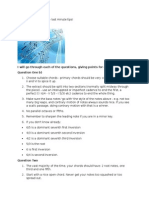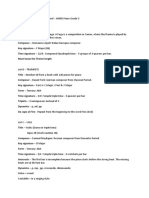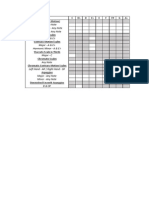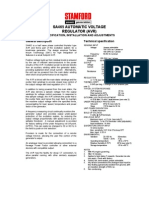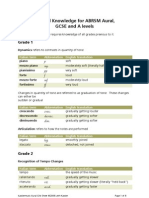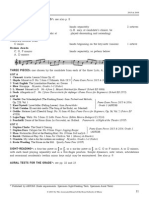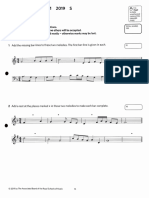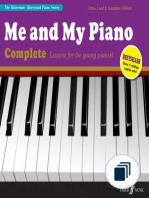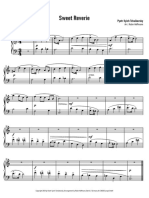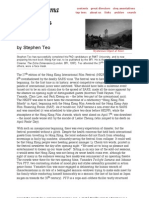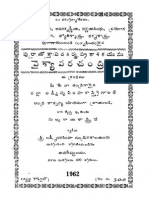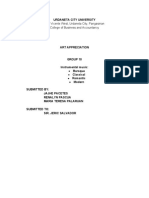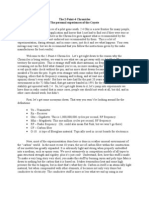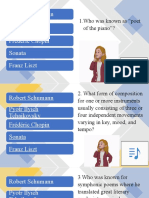Grade 8 Aural Notes
Grade 8 Aural Notes
Uploaded by
Christopher LimCopyright:
Available Formats
Grade 8 Aural Notes
Grade 8 Aural Notes
Uploaded by
Christopher LimOriginal Description:
Copyright
Available Formats
Share this document
Did you find this document useful?
Is this content inappropriate?
Copyright:
Available Formats
Grade 8 Aural Notes
Grade 8 Aural Notes
Uploaded by
Christopher LimCopyright:
Available Formats
Grade 8 Aural Notes Renaissance Period Intruments: Pipe organ, banjo, guitar (lute) homophonic Church purpose with
h choir setting Texture: Polyphonic Tonality: Church mode (no clear demarcation between major & minor) Dynamics: One basic affection, one level throughout. Melismatic stepwise Famous composers: Palestrina, William Byrd Baroque Period Instrument: Harpsichord (short and detached, cannot play legato due to unsustainable keys) Texture: Contrapuntal (Sequence, theme repeated in different parts) Tonality: Major/minor (Major preferred) Dynamics: loud or soft (f and p) Style: Immitation, likes to end with tierce de Picardie (Major) Prelude improvisation, motor-like rhythm, homophonic Ornaments: Plenty Famous composers: J S Bach, Scarlatti, Handel Classical Period Instrument: Piano Texture: Homophonic Tonality: Major/minor (slight chromaticism and modulations more towards major) Dynamics: Crescendo, diminuendo Style: Alberti bass, chordal Speed: Legato, cantabile Form: Binary & ternary Phrasing: 2/4 bar phrase, seldom irregular Famous composition: Minuet (Dance in triple time, part of sonata) Famous composers: Haydn, Mozart, Beethoven, Schubert Romantic Period Character piece: Nocturne, bagatelle, impromptu, scherzo, waltz (triple time), ballad Texture: Homophonic Tonality: Major/minor with more chromaticism and modulations to remote (unrelated) keys Dynamics: wide range (ff and pp) Style: Chordal Form: Ternary (more), arpeggiated Famous composers: Early Chopin, Liszt, Mendelssohn, Schumann Midlle Brahms Late Albeniz, Grieg, Tchaikovsky 20th Century Dynamics: Very wide (fff to ppp) Debussy, Ravel - Impressionism - Use of pentatonic scale, whole tone scale - Lots of chromaticism Rhythm: Free flow Bartok - Nationalism, own culture - Rhythmic Schoenberg - Serialism - Atonal (no tonality) - 12 keys all treated equally - Sound: Very dissonant Stravinsky - Neoclassicism - No downbeat (no bar lines) - Clashing sounds
You might also like
- Music Theory Grade 5 Sample Model AnswersDocument5 pagesMusic Theory Grade 5 Sample Model AnswersMusicflat Carvalhos50% (4)
- Specimen Aural Test 1 - 3Document40 pagesSpecimen Aural Test 1 - 3Enric100% (1)
- ABRSM Music Theory Grade 1 by Sharon Bill A4 PDFDocument27 pagesABRSM Music Theory Grade 1 by Sharon Bill A4 PDFNguwruw Chungpha Moyon100% (3)
- Grade 8 Aural Perception HelpsheetDocument4 pagesGrade 8 Aural Perception HelpsheetTom Mole100% (2)
- Dragonfleis Marjorie HelyerDocument1 pageDragonfleis Marjorie HelyerSeray KalelioğluNo ratings yet
- Grade 6 Aural GuideDocument6 pagesGrade 6 Aural GuideJamielcm100% (2)
- ABRSM Grade 8 Scales Arpeggios Piano 2021 OnwardsDocument1 pageABRSM Grade 8 Scales Arpeggios Piano 2021 Onwardsmary-anneNo ratings yet
- ABRSM Grade 6 TheoryDocument4 pagesABRSM Grade 6 Theorydennn57% (7)
- ABRSM Music Theory Grade 7 Pointers Q1 Q2 Q3Document1 pageABRSM Music Theory Grade 7 Pointers Q1 Q2 Q3Robert & Angela0% (1)
- Programme Notes ATCL Piano NewestDocument5 pagesProgramme Notes ATCL Piano Newestkaren12laik100% (3)
- Grade 5 Theory Revision NotesDocument6 pagesGrade 5 Theory Revision Noteskrt890100% (10)
- Grade 8 Theory Paper AbrsmDocument3 pagesGrade 8 Theory Paper AbrsmVanessa0% (5)
- AMEB Piano 3 General KnowledgeDocument2 pagesAMEB Piano 3 General KnowledgeCarla Angelica Sella Marianayagam0% (1)
- Two Grade 3 Sight Reading Exercises PDFDocument1 pageTwo Grade 3 Sight Reading Exercises PDFRowan Grant Bakker100% (1)
- ABRSM Piano Grade 6 Scales and ArpeggiosDocument2 pagesABRSM Piano Grade 6 Scales and ArpeggiosConrad EdwardsNo ratings yet
- Virginia Hall Shruthi RajasekarDocument1 pageVirginia Hall Shruthi RajasekarSeray Kalelioğlu100% (1)
- The Quiet Wood Machine HeadDocument1 pageThe Quiet Wood Machine HeadSeray KalelioğluNo ratings yet
- Grade 5: THREE PIECES: One Chosen by The Candidate From Each of The Three Lists, A, B and C For Further Details SeeDocument12 pagesGrade 5: THREE PIECES: One Chosen by The Candidate From Each of The Three Lists, A, B and C For Further Details SeeLucas Moreira100% (1)
- Abrsm Aural (GRD 1 - 8)Document8 pagesAbrsm Aural (GRD 1 - 8)Andri Kurniawan100% (1)
- Grade 8 Aural NotesDocument3 pagesGrade 8 Aural NotesWang Xin YiNo ratings yet
- Grade 5 Theory ClassesDocument5 pagesGrade 5 Theory ClassesGeorgie SNo ratings yet
- Grade 8 Aural EditDocument15 pagesGrade 8 Aural EditMichael LeachNo ratings yet
- Grade 5 Theory Sample QuestionsDocument7 pagesGrade 5 Theory Sample QuestionsNicole Paul100% (1)
- Music Theory Practice Paper Grade 5 PDFDocument7 pagesMusic Theory Practice Paper Grade 5 PDFMaiah Phylicia Latoya100% (1)
- Aural Test Grade 8Document1 pageAural Test Grade 8toscanini2008No ratings yet
- Grade 5 Scales ArpeggiosDocument1 pageGrade 5 Scales Arpeggioskussi100% (1)
- ABRSM Theory Musical Terms For Performance DirectionDocument9 pagesABRSM Theory Musical Terms For Performance DirectionKirsty Kwok25% (4)
- Codes and Conventions of Music VideosDocument3 pagesCodes and Conventions of Music Videosapi-374922721No ratings yet
- Especificaciones Tecnicas AVR Stamford SA465Document4 pagesEspecificaciones Tecnicas AVR Stamford SA465MH..2023No ratings yet
- ABRSM AuralDocument8 pagesABRSM AuralErik Gunawan100% (7)
- Piano Initial 2021 2022 Rev Sep 2020 PDFDocument12 pagesPiano Initial 2021 2022 Rev Sep 2020 PDFabhiyanNo ratings yet
- Test A: Aural Help Grade 8Document2 pagesTest A: Aural Help Grade 8Jenny Randall100% (1)
- Grade 7 Reconstruction q2Document25 pagesGrade 7 Reconstruction q2dennn50% (2)
- (ABRSM) ABRSM - Music Theory Marking Criteria - Grades 1-5Document16 pages(ABRSM) ABRSM - Music Theory Marking Criteria - Grades 1-5FantasiBintang100% (1)
- Improve Your Aural Grade 8 AnswersDocument3 pagesImprove Your Aural Grade 8 AnswersOlsi QinamiNo ratings yet
- A Morning Sunbeam Florence B. Prince A Morning SunbeamDocument1 pageA Morning Sunbeam Florence B. Prince A Morning SunbeamSeray KalelioğluNo ratings yet
- Music Theory Practice Paper Grade 5 (All Languages) - ResultDocument9 pagesMusic Theory Practice Paper Grade 5 (All Languages) - ResultGrace ChooNo ratings yet
- Grade 8 Aural TipsDocument2 pagesGrade 8 Aural TipsJenNo ratings yet
- Guidance For ABRSM Aural Tests GRADE 8Document2 pagesGuidance For ABRSM Aural Tests GRADE 8ChristineMarieUy100% (1)
- Theory Practice Paper 2023 Grade 5 CDocument10 pagesTheory Practice Paper 2023 Grade 5 Crui chenNo ratings yet
- ABRSM Piano Grade 1 SyllabusDocument2 pagesABRSM Piano Grade 1 Syllabus*_niomi_*No ratings yet
- 493 Pupil Book ABRSM Grades 6 To 8Document16 pages493 Pupil Book ABRSM Grades 6 To 8Anonymous DMDqWe100% (7)
- Piano 2023 2024 Grade 6Document13 pagesPiano 2023 2024 Grade 6Lucas Moreira0% (1)
- ABRSM Grade 1 2019 SDocument4 pagesABRSM Grade 1 2019 STravis Mc DowallNo ratings yet
- Aural Training Grade 8Document3 pagesAural Training Grade 8William SoNo ratings yet
- Aural Grade8ABRSMDocument3 pagesAural Grade8ABRSMLoveHobelia50% (2)
- 17 Performance Grades Qual Spec - Piano 2025 & 2026 20240603 - AccessDocument28 pages17 Performance Grades Qual Spec - Piano 2025 & 2026 20240603 - AccessMarta PereaNo ratings yet
- Grade 5 Theory RevisionDocument1 pageGrade 5 Theory RevisionDan Johnson100% (2)
- ABRSMDocument6 pagesABRSMhurlyhutyoNo ratings yet
- Piano Star Grade 1 - Taking A Naughty Dog For A Walk Lesson IdeasDocument1 pagePiano Star Grade 1 - Taking A Naughty Dog For A Walk Lesson IdeasAnh Thu LENo ratings yet
- Improve Your Aural Grade 7 AnswersDocument5 pagesImprove Your Aural Grade 7 AnswersOlsi QinamiNo ratings yet
- ABRSM Classical Piano Grade 1 ScalesDocument3 pagesABRSM Classical Piano Grade 1 Scalesdeathmouse100% (1)
- Music Theory: DiscoveringDocument5 pagesMusic Theory: DiscoveringAby MosNo ratings yet
- Improve your sight-reading! A piece a week Piano Grade 5From EverandImprove your sight-reading! A piece a week Piano Grade 5Rating: 3.5 out of 5 stars3.5/5 (3)
- Bite-Size Music Theory Flashcard Book for ABRSM Music Theory Grade 1From EverandBite-Size Music Theory Flashcard Book for ABRSM Music Theory Grade 1Rating: 5 out of 5 stars5/5 (1)
- Improve your sight-reading! A Piece a Week Piano Grade 4From EverandImprove your sight-reading! A Piece a Week Piano Grade 4Rating: 5 out of 5 stars5/5 (1)
- Technical Specification Ac40Document7 pagesTechnical Specification Ac40LucioEidyTakemotoNo ratings yet
- Sweet Dreams - ScoreDocument1 pageSweet Dreams - ScoreMariaSole IndirliNo ratings yet
- 451 - in Moments Like These: Lead SheetDocument2 pages451 - in Moments Like These: Lead SheetRobson GodoyNo ratings yet
- Livre Communication Progressive Du Francais Niveau Débutant - CompressedDocument132 pagesLivre Communication Progressive Du Francais Niveau Débutant - CompressedAlexisNo ratings yet
- RP Blade2 ManualDocument100 pagesRP Blade2 ManualxorglobNo ratings yet
- Face Masks at The 27th HKIFFDocument5 pagesFace Masks at The 27th HKIFFMohammad RizaNo ratings yet
- Puranokthahprakashika - ChellaDocument184 pagesPuranokthahprakashika - Chellanvravi91% (11)
- Moama Anglican Grammar SchoolDocument8 pagesMoama Anglican Grammar Schoolapi-26012552No ratings yet
- CTE Cataloque 2010 LowDocument84 pagesCTE Cataloque 2010 Lowsw1kwcNo ratings yet
- Lab Exam Lic VivaDocument1 pageLab Exam Lic Vivaarun@1984No ratings yet
- Sor Study in C-TabDocument2 pagesSor Study in C-Tabharryjones999No ratings yet
- Arts AppreciationDocument5 pagesArts AppreciationPASCUA RENALYN M.No ratings yet
- Description: P Ack AgeDocument3 pagesDescription: P Ack AgeAlexandru CioponeaNo ratings yet
- Wrong Angle Is Right Angle: Brand: Alpenliebe Category: Best Media Innovation TVDocument5 pagesWrong Angle Is Right Angle: Brand: Alpenliebe Category: Best Media Innovation TVkdebangshiNo ratings yet
- Lil 50 - Google SearchDocument1 pageLil 50 - Google Searchokerebrendan618No ratings yet
- Essential Questions For Physics: Overarching Enduring UnderstandingsDocument10 pagesEssential Questions For Physics: Overarching Enduring UnderstandingsShiny NivolyaNo ratings yet
- Fourth Series Product BrochureDocument24 pagesFourth Series Product BrochuregugiumanionutdragosNo ratings yet
- Overlap in Rectifiers Overlap in Rectifiers: Advance Power Electronics Advance Power ElectronicsDocument10 pagesOverlap in Rectifiers Overlap in Rectifiers: Advance Power Electronics Advance Power ElectronicsJunaid AlviNo ratings yet
- American Radio Relay League - Hints and Kinks For The Radio Amateur (1992, American Radio Relay League (ARRL) )Document175 pagesAmerican Radio Relay League - Hints and Kinks For The Radio Amateur (1992, American Radio Relay League (ARRL) )Baud WolfNo ratings yet
- The 2-Point-4 Chronicles FinalDocument25 pagesThe 2-Point-4 Chronicles FinalNoah Richards100% (1)
- Multisync E231W: User'S ManualDocument21 pagesMultisync E231W: User'S ManualyenmiclesNo ratings yet
- rolling in the deep 歌词Document4 pagesrolling in the deep 歌词314663630qq.comNo ratings yet
- Gigolos Get Lonely Too (Audition Cut) 24-0214 - PIANO:VOCAL 2Document4 pagesGigolos Get Lonely Too (Audition Cut) 24-0214 - PIANO:VOCAL 2Micheal HasselNo ratings yet
- Jet DiffuserDocument5 pagesJet Diffuserntt_121987No ratings yet
- Speak Cki 7Document2 pagesSpeak Cki 7giasutaihue1No ratings yet
- Ims For Mapeh9 Lesson 1Document31 pagesIms For Mapeh9 Lesson 1Nathalia BaclayoNo ratings yet
- A Hip Hop ActivityDocument3 pagesA Hip Hop ActivitydglNo ratings yet
- A Raisin in The SunDocument5 pagesA Raisin in The Sungabby ficoNo ratings yet







